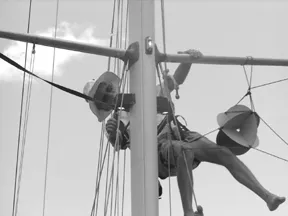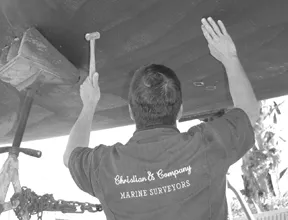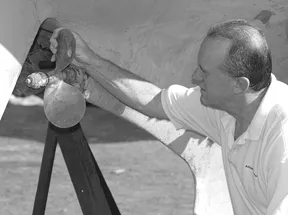
So, it’s the happiest day of your life because you just bought a sailboat. No, it’s the happiest day of your life because you just sold your boat. Either way, completing this kind of transaction typically involves a survey and, occasionally, elevated blood pressure readings. If you are doing the survey for the “right” reason—to assure the safety of skipper and crew—you want to be advised of potential hazards or failures, and the event may be a walk in the park. If you are evaluating a boat to determine its fair market value before writing a check, or are going through the motions because you were instructed to by an insurance company, you may have your fingers crossed that the surveyor doesn’t find too many defects.
Regardless, the person in the middle of the process is a surveyor whose education, experience, and temperament will factor heavily in the evaluation of the vessel. Fortunately, in the past 20 years, the practice of surveying has evolved to produce surveyors that fit the classic definition of a professional.
Historically, surveyors often were retired shipwrights, vessel operators, or designers who made surveying a post-retirement (and, often, part-time) career. Like the members of any work force, some did a better job of keeping current with construction technologies and methods than others. These days, the pros have distanced themselves from the part- timers by establishing organizations that have formal admission, ethics, and continuing education requirements, all of which can benefit buyers and sellers, along with banks and insurance companies.
Qualifications
Of the community of surveyors—whose population is unknown—some 1,800 are members of two organizations formed to create operational and educational standards for the profession. The National Association of Marine Surveyors (NAMS) was formed in 1962 and presently boasts 800 members—a number recently on the decline. This organization designates members who meet its eligibility requirements as Certified Marine Surveyors (CMS).
The Society of Accredited Marine Surveyors (SAMS), was formed in 1987. Its membership has grown to 1,000 surveyors. SAMS’ professional designation is Accredited Marine surveyor (AMS).
According to Michael J. Schiehl, chairman of the NAMS Qualification and Certification Committee, “Each candidate must meet certain experience requirements, be recommended by his peers, and pass a rigorous examination in his specialty.”
Joe Lobley, a SAMS regional director, said, “SAMS has different classifications. An ‘SA’ is a Surveyor Associate (someone who is in the learning process); an ‘AMS’ is an Accredited Marine Surveyor. To achieve the latter designation, an SA must have fulfilled specific educational requirements, performed a certain number of surveys, passed a review board, and passed an extensive AMS exam.”
A major difference between the organizations, explained Schiehl, is that “In order to maintain the CMS status, he/she must document at least six continuing education hours yearly. Failure to do so results in loss of the CMS status until such time as the CE credits are attained and accepted.” In comparison, Lobley told us that “An AMS must gain continuing educational credits during a set time frame or be dropped from membership.” Another crucial difference is that NAMS members cannot engage in selling or repairing boats at the same time that they’re surveyors, whereas SAMS members aren’t restricted in this way.
Both organizations endow the industry with a level of professionalism, and both claim that lending institutions and insurance companies are becoming predisposed to requiring a NAMS or SAMS survey.
“SAMS members’ written surveys must follow a recommended content, but are still unique to each surveyor,” Lobley explained. And the NAMS website lists the items that NAMS members evaluate during a survey.
Many marine surveyors are also members of the International Association of Marine Investigators, a non-profit organization formed in 1986. IAMI membership requires broad experience in many areas including insurance adjusting and marine surveying.
Though many surveyors agree that there are non-members who are qualified to perform surveys, to hedge our bets, PS would opt for a member of one of these organizations whose certification is current. As a consequence, only SAMS or NAMS members with current certifications were interviewed for this article. Some are also IAMI members.
Form vs. Substance
Boat surveys primarily come in three flavors: prepurchase, insurance, and damage assessment, the last specialty more closely resembling a police investigation.
The pre-purchase survey is the most comprehensive, and is strongly advised (or required by a bank) when purchasing a new or used vessel. The surveyor’s approach is to assess the condition and overall operation of the vessel, including structural integrity, electrical systems, the propulsion system, the fuel system, other machinery, navigation equipment, miscellaneous on-board systems, cosmetic appearance, electronics, and overall maintenance. In most cases, the boat will be hauled to inspect the condition of the bottom and appendages, including the drive shaft, cutless bearing, and propeller.
For most surveyors, the expense of a sea trial is an add-on that, if chosen, might best include taking along a reputable sailmaker (ideally one with a performance background) who can provide an assessment regarding the condition of the sails, and an evaluation of the boat’s performance.
“Surveys for insurance companies are conducted primarily to assure the underwriter that the vessel is basically sound and worth the amount of money for which it is being insured,” said Kells Christian, a surveyor in San Diego, CA. The insurers are interested in structural integrity and safety for the vessel’s intended use, and also want to know the vessel’s fair market value.
An expanding field, damage assessments are performed to determine the extent of damage, recommend repairs, estimate repair costs, and, if requested, provide a possible cause for the claim. Regarding this category, Jane Christen of Michel & Christen, a surveying firm in Seattle, told us that surveyors there play the game on a different field.
“We are hired by insurance companies to evaluate the cause of damage and provide a written description of the work, and reasonable cost, necessary to return the vessel to its original condition.”
From an educational standpoint, these surveyors are more like Inspector Clouseau in that “We take a different educational path that involves intensive training in boat systems, and studies of the causes of common types of failures,” explained Christen. “We need to know where to look for the cause of the damage, and how to articulate the requirements for a repair.”
Of their approach, partner Rex Michel said, “I feel like I’m working for the boat, not the company or the insured, to effect a solution that puts the boat back in its original condition.”

If assessing the damage from an incident is what you require, your best bet is to select a surveyor who specializes in this particular niche.
Your Survey
What should you expect of your surveyor and the resulting survey? The surveyors with whom PS spoke were candid. They characterize owners and buyers in three groups: 1) those going through the motions because they have to; 2) informed owners/buyers who want to be assured that all systems are functional on board; and 3) newcomers to the pastime who don’t know how or where to look for, or deal with, defects. And they all agree that forming a relationship with the client is an important ingredient in the process.
Greg Davis, president of Davis Company, Ltd., the largest surveying company in the U.S., is chairman of NAMS’ Yachts and Small Craft Committee. Of the surveyor-client relationship he said: “It should be initiated on the basis of trust. And, the buyer should be looking at the purchase without rose-colored glasses,” which could translate to disappointments in the form of a vessel not being purchased, sales commissions being lost, or an unhappy seller. That is not Davis’ concern, he told us. In fact, he was the only surveyor with whom we talked who considers the inclusion of prices for comparable boats as part of a complete survey.
“We do the same thing when we buy a house, don’t we?” asked Davis.
Another surveyor, Gloucester, MA-based Gene Barnes, told us that “Personal compatibility is important. If you (the client) can’t relate to the surveyor on the phone, you will likely not be able to have him understand or relate to your situation. There are plenty of technicians that know a lot about boats, but cannot relate that information to their clients. All good surveyors should have technical ability, but some are better than others at putting it into ‘human’ terms.”
Tom Hill, also of Gloucester, presents a written agreement between surveyor and purchaser that specifies his role and responsibility. “I don’t know enough about rigging or mechanical systems to properly evaluate them, so I recommend that experts in those fields be brought in. And, no surveyor has X-ray vision, so we can’t be expected to see what’s behind a panel or cabinet. We can only detect visible defects that exist now, but cannot predict future events.”
His point is well taken. The cost of a survey always plays a part in the equation, with low-bidders often being awarded the assignment. However, as Hill stated, “A buyer could not afford a survey that included removing cabinetry or other obstacles to conduct a thorough evaluation of a boat.” So, at best, a survey will reveal only those areas in which visual flaws are found or suspected.
Kells Christian in San Diego said he encourages clients “to participate in the survey, especially neophytes, because I teach them how things work and the type of maintenance programs that are necessary.”
Be aware that surveyors typically stipulate that the survey is good for a specific period of time. This serves to protect the surveyor from legal action that might arise if a boat experiences system failures some time after the survey has been conducted. “I tell clients that a survey is only good for 15 days,” one surveyor said. “If the boat is purchased six months later, the survey is not valid,” so buyers assume an unnecessary risk when relying on an old survey.
In which areas are flaws most likely to occur? SAMS president Jim Wood told us: “All areas are subject to deficiencies. Even on new boats.” At the top of his short list is standing rigging: “If it’s over five years old, I would expect to find a myriad of potential failures: broken wire, cracks, corrosion, bent toggles, tangs and turnbuckles, corrosion at the chainplates.” Of masts and booms, he noted the most common ailments are “mast out of column, corrosion, cracked spars, fasteners, welds, gooseneck, and prior repairs.” Of hull inspections: “Fiberglass blisters, wood rots, steel rusts, and aluminum corrodes, so pick your poison. Seacocks should be checked for function and accessibility. Most hull-to-deck joints are poorly designed and fastened with machine screws. Look for daylight and leaks.” Other major items are the mast step, where corrosion may occur; the keel attachment, which should be checked for “smiles,” bolt tension and corrosion; the rudder attachment for lubrication; steering apparatus for worn cables, quadrant tension, and range of motion; and rudder delamination.
Gene Barnes explained: “Unless I have been alerted to past problems, I will seldom look for a specific problem area. I usually let the vessel speak for itself and discover the problem areas during the course of the survey. Often boats that may look tough to start with end up OK, and other vessels that appear OK may have a fatal flaw, such as wet keel floors, or a compressed maststep.
“Occasionally, I will discover one area that will lead to problems in another that are significant enough to stop the survey. Wet core material in the decks, wet rudders, and wet keel floors are the most common. Rudders are fairly easy to fix, wet decks and wet keel floors or stringers can be very expensive,” he added.
SAMS regional director Joe Lobley said “All of these are important, plus tabbing, grid work, fuel systems, engine systems, including all plumbing and exhaust, condition and installation of batteries, compliance with current USCG and NFPA (National Fire Protection Association) for safety items, and overall value. I expect to find problems almost anywhere, which is why a complete examination is necessary.”
Beyond assessing the condition of a boat in minute detail, the majority of surveyors share the firm belief that they play no role in the sales process.
James Wood summarized a general opinion that strikes fear in the hearts of brokers and dealers: “Brokers negotiate, surveyors present findings. A word of caution: Don’t let the broker push you into the deal. Get the survey before you sign on the dotted line or make an offer, and make the sale contingent on the results of the survey. Then let the broker or buyer negotiate the price. Why would you agree to buy at a certain price prior to survey, particularly in light of the fact that you’re going to have to have a survey for financing and/or insurance anyway? My job is to deal with the facts/findings and present them to the buyer/lender/underwriter. I’m not an advocate for either side.”
Woods’ opinion runs contrary to the process that typically occurs in a transaction, but is worth considering. Though home inspections typically take place after an offer has been accepted, an important difference exists in the fact that boats spend the majority of their lives submerged in water.
Lobley added, “I step out of the final negotiations, report the condition, and let the parties negotiate. The sale of a vessel usually comes down to how much the seller will take off for the needed corrections on safety items.”

And Gene Barnes added, “In my opinion, the surveyor’s job is to speak for the boat, but since boats are bought and used by people, good surveyors are able to relate well to people. I will suggest a client not purchase a specific vessel if they ask, and I’ll provide information that supports such an opinion. Clients who indicate that they are unsure of what they are doing are generally treated more cautiously than a knowledgeable buyer that understands what is involved with owning a used boat. With knowledgeable buyers, I will generally put the information on the table and let the buyer and seller work it out. If asked by a neophyte buyer, I will provide guidance, but usually in broad terms rather than specifics that relate to a given vessel or purchase.”
This explains the tension we observed during a recent survey in the presence of buyer, seller, and broker. Upon the discovery of a soft spot in the bottom of a 20-year-old fiberglass vessel, the surveyor took the conservative approach and recommended that the area be laid open for further examination, and left it to the three unhappy parties to agree on a course of action.
Conclusions
Boat surveys bear a striking resemblance to physical examinations that are conducted when you’re feeling fine, but you nonetheless consult your MD to see if you’re sick. You may not want to know that you have some affliction, but the knowledge might affect the manner in which you conduct your life. The same holds true for your boat. It is easy to avoid dealing with a failing through-hull when you’re unaware of it, but your ignorance may put you and others in harm’s way.
If you’re in the market for a surveyor, it’s prudent to first check that person’s credentials. Then, seek recommendations from boat owners who have previously engaged that person’s services. Finally, make sure you understand what you’ll be charged, how extensive the survey will be, and what form the end product will take.
Also With This Article
“One Boat—Two Takes”
“What Surveys Cost”
Contacts
• NAMS, 800/822-6267, www.nams-cms.org
• SAMS, 800/344-9077, www.marinesurvey.org
• Christian & Co, 800/944-4789, home.fda.net/~ychtsrvy
• Michel & Christen, 800-794-0089, marinelosssurveyors.com
• Davis Co., Ltd., 800-223-8816, www.daviscoltd.com
• Gene Barnes, 978/281-6040
• Tom Hill, 978/283-7006
• James Wood, 800/693-3832, www.marinesurveyor.com/jwood
• Joe Lobley, 978/774-5060, www.marinesurveyor.com/leblanc
• Lynne Reister, 206/282-6003
• Sam Colt, 360/387-4030, www.coltmarsurv.com

































